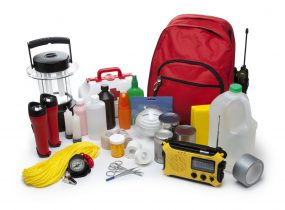How to Create a Thorough Emergency Readiness Strategy
In the realm of preparedness, establishing a detailed emergency situation plan is not simply a job to mark off a list; it is a necessary foundation of any organization or individual's durability method. From all-natural disasters to unexpected dilemmas, the capability to expect, minimize, and react efficiently can imply the difference between disorder and control. By diligently crafting a strategy that attends to different aspects of emergency situation administration, including risk assessment, communication procedures, source appropriation, and calculated decision-making, one can lay a strong structure for safeguarding lives, possessions, and operations. However, the real efficacy of such a plan lies not only in its creation but also in its recurring maintenance and adaptation to developing difficulties and threats.
Significance of Emergency Situation Readiness
Emergency preparedness is critical for minimizing possible risks and making sure the safety of people and neighborhoods. In today's globe, where natural catastrophes, public wellness situations, and various other emergencies can strike without warning, being prepared can make a substantial difference in lessening the effect of these occasions. By having a well-thought-out emergency readiness strategy in position, companies and individuals can react effectively, secure lives, and lower residential property damage.
One of the main reasons that emergency preparedness is crucial is its role in saving lives. Having a strategy that outlines clear treatments for interaction, emptying, and emergency situation feedback can help individuals act swiftly and decisively when emergency situations occur (next). This can prevent injuries and deaths by guaranteeing that people know what actions to take to remain secure
In addition, emergency preparedness enhances the resilience of areas. By promoting a society of preparedness and preparation for various scenarios, neighborhoods can bounce back faster from interruptions and calamities. This strength is necessary for maintaining stability, continuity of operations, and overall well-being despite adversity.
Assessing Potential Dangers
Taking into consideration the relevance of being prepared for unpredicted events, the initial step in creating a reliable emergency readiness strategy includes thoroughly examining and examining possible threats. This assessment calls for a comprehensive review of all feasible threats that might impact the organization, taking into consideration aspects such as place, industry, and historic information on occurrences. By determining these threats, companies can prioritize their readiness efforts and allocate resources successfully to minimize one of the most considerable dangers.
Typical risks that organizations might deal with include all-natural calamities like floodings, hurricanes, or quakes, technical risks such as power outages or data breaches, in addition to human-caused threats like accidents or willful acts of violence. Performing a danger assessment additionally entails taking into consideration the prospective impact of these occasions on the company's procedures, employees, consumers, and track record. By conducting a comprehensive threat evaluation, companies can develop customized emergency feedback plans that address their certain susceptabilities and guarantee reliable preparedness for any type of possible crisis.
Producing an Interaction Strategy
Establishing a comprehensive and clear communication plan is important for efficient emergency situation preparedness within companies. In times of dilemma, interaction plays a critical role in making certain the safety and wellness of staff members, stakeholders, and the community. A well-thought-out interaction strategy need to describe clear lines of communication, mark crucial workers in charge of communication tasks, and establish protocols for sharing info swiftly and precisely.
One key aspect of producing an interaction strategy is identifying alternative and primary communication channels (EMERGENCY PREPAREDNESS). These can consist of e-mail, message messaging, phone trees, social media systems, and public address systems. It is crucial to ensure that these channels are reputable, obtainable, and regularly tested to ensure their effectiveness throughout emergencies

Building an Emergency Kit
Offered the essential importance of readiness in times of situation, a crucial part that companies need to resolve is the facility of an emergency situation kit. When putting together an emergency situation set, it is important to take into consideration the details needs and circumstances of the organization. Furthermore, organizations need to consist of crucial documents, such as call listings, insurance policy details, and emergency response strategies, in waterproof containers within the package.
Developing Discharge Procedures
To ensure the safety and orderly emptying of employees throughout emergency situations, organizations need to establish clear and efficient evacuation procedures. Evacuation procedures ought to incorporate a range of possible situations, including fires, all-natural catastrophes, or various other emergency situations that call for speedy emptying.

In addition, organizations need to establish a system for bookkeeping for all workers throughout an evacuation to guarantee that everybody has safely exited the properties. Communication plays an essential role in evacuation procedures, with clear guidelines on exactly how to leave and when to do so. Normal testimonial and updating of evacuation treatments based upon feedback and transforming scenarios are vital to keeping the effectiveness of the plan.
Final Thought
Finally, creating a detailed emergency readiness strategy is important for making sure the safety and security and well-being of individuals in case of a catastrophe (EMERGENCY PREPAREDNESS). By analyzing potential threats, developing a communication strategy, building an emergency kit, and establishing evacuation individuals, organizations and procedures can be better furnished to react efficiently to emergency situations. It is very important to focus on preparedness initiatives to minimize the influence of catastrophes and secure lives and residential property
In the world of preparedness, creating a thorough emergency strategy is not simply a task to examine off a list; it is a vital cornerstone of any kind of organization or individual's strength approach. When emergency situations happen, having a strategy that outlines clear treatments for evacuation, interaction, and emergency action can help individuals act swiftly and decisively. have a peek here. By carrying out an extensive danger evaluation, organizations can establish tailored emergency situation feedback plans that resolve their particular vulnerabilities and make sure reliable readiness for any kind of prospective dilemma
Creating a comprehensive and clear communication plan is necessary for reliable emergency preparedness within organizations. By analyzing potential risks, creating a communication strategy, developing an emergency situation package, and developing evacuation organizations, people and treatments can be much better equipped to react successfully to emergency situations.